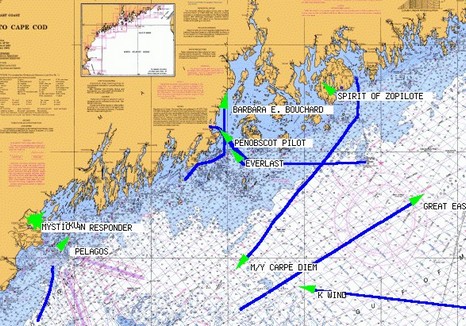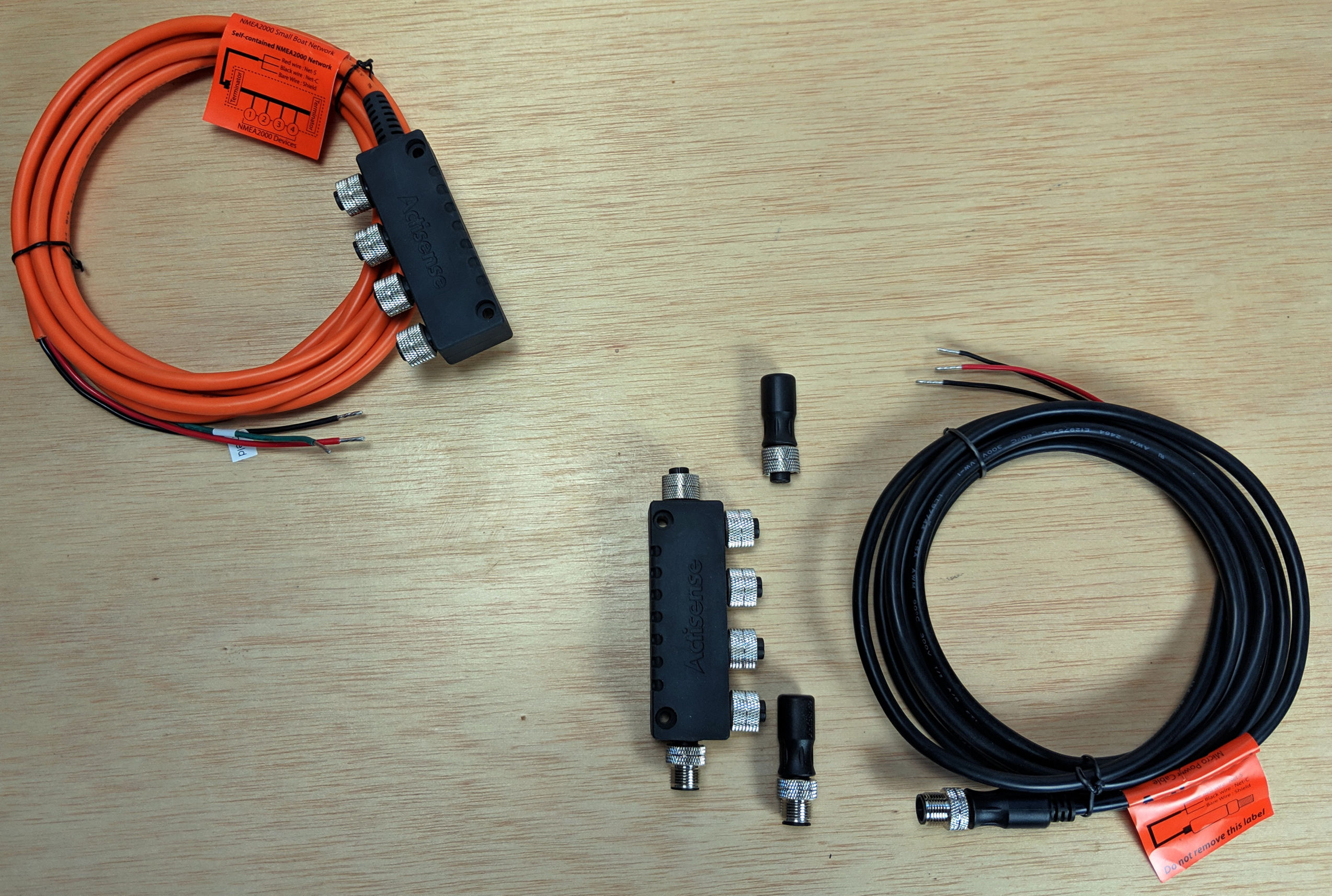AIS on the Web, an update

I guess it’s a little pathetic—me spending so much time on the Web, instead of on the water—but I have enjoyed using SeaLinks AIS Live, above, to keep track of some bigger yachts visiting Maine this summer. As of yesterday, Shine Micro, aka SeaLinks, is making users register but it’s easy and free. I don’t know where their receivers are positioned but they surely work well, as seen in the screen shot bigger here. That chart is about 150 miles wide, and Spirit of Zopilote is tucked into Southwest Harbor surrounded by hills. It’s hard to make out even on SeaLink’s small area chart of Portland, but that’s where the 228’ Floridian is now. I first saw her off Camden via AIS last Friday, then in the mega flesh shown below, but AIS couldn’t alert me to the fact that ex President Bush would lunch aboard on Monday. It gets wild around here this time of year! (Here’s the photo bigger, easier to make out the owner’s team—the Miami Dolphins—logo on the copter tail and the Intrepid “tender”, which has triple 285’s on its stern).

PS. It’s amazing how many different ways there are to display AIS on the Web, and new ones seem to crop up every week. Here’s San Francisco Harbor with the ships animated, and here’s shipping along the coast of Germany overlaid on Google Maps or Google Earth (if you register, and have GE installed, but very, very cool). And don’t forget classics like the Irish Sea and the grand daddy of them all, AISLive.com (which also requires registration, but covers many coasts). Enjoy.
PPS. Rosepoint Navigation is testing eight different AIS receivers from Milltech Marine, SeaLinks/Shine Micro, and SeaCas, and we plan to publish the results here on Panbo. Stay tuned (so to speak).
PPPS. The world of AIS, and Panbo, is large. Jan Egholm, part of a team running a commercial AIS service in the Faroe Islands, just sent along this image demonstrating how well a Shine Micro receiver can work on a 750 meter hill. Those AIS targets stretch from Iceland to Norway! Jan’s company Web site is a little tough to read because it’s in Faroese, but here’s a PDF explaining Vikmar’s service in English (there’s much more to Web AIS than megayacht ogling).














I notice some of these internet based AIS plotting services have some hefty fees. Who would subscribe to these services? What are some of the possible uses for land based subscribers to this service?
How are they tracking all the AIS signals around the world?… From a very high antenna(s) at a land based station?
If this is a collision avoidance system, why don’t naval craft have some sort of AIS signal?
Jef
sv Shiva
Contest 36s
I am starting a completly free AIS website we are beta testing currently but anyone with an AIS reciever and broadband who wishes to share there data please contact me murray (at) murraymarine.co.uk
You know AIS is a great facility for all mariners. The big ships can see each other, VTS and CG can monitor shipping and we little ones can stay out of the way of big ones. At the moment that’s great. But what happens when every kayak, catamaran and cod catcher fits a transmitter as well as a receiver? Screens will be so cluttered they will be unusable until some sort of filter is developed. This is one thing that NOT everyone should have.
Good navigation software will let you filter which targets you want to “see”. For example “stationary” and/or “underway”. Private small craft will use the “B” class transponders where larger commercial traffic will use the “A” class. While I agree clutter can become a problem, I would rather have the opportunity to see “everything” I want.
When more or all vessels have AIS transponders the software to manage and process the data will have to increase in capability. For examplen the notion of a gaurd zone may not be as important as CPA and TCPA… which are the real deal as far as collisions are concerned. Another power over taking you off your beam is not a real concern.. but one on a collision couse IS… even when anchored and YOU are moving. But the software can handle this. In a suoper crowded area you need to be watching from the deck and not looking at some instrument display which is meta reality. The you need to rely on real reality.
I only see AIS as a fabulous feature and the best thing since sliced bread in navigation since GPS.
Jef
sv Shiva
Contest 36s
Ben,
What is the actual penetration of AIS in the USA? I asked a captain of a very large motor yacht docked in Dering Harber, Shelter Island which clearly had sat com and all sorts of nav gear if he had AIS and he said, “No!”… which surprized me.
The ferry running between Greenport and Shelter Island does not use AIS either… what gives?
I have also had casual conversations with other yachtsmen and most have never heard of AIS. Although that is more understandable because AIS is not a requirement for private yachts (yet)… but as a collision avoidance item which IS avaible quite economically it seems odd that hardly anyone has got the news.
Is this because the main electronics companies are not offering their own AIS receivers yet? I am using the NASA which is from UK.
Why has this been so slow on the uptake here in the USA?
In visiting one of the online AIS services I saw only 2 or 3 AIS targets in all of down east Maine… Could that be?
Jef
sv Shiva
Contest 36s
You’re right, Jef, it’s just penetrating some areas, markets, and brains! The Maine Ferry Service doesn’t use it, for instance. Yet. New requirements are in the works, 10-17,000 U.S. vessels worth, which I will write about soon. Also, at SeaLinks today I see three AIS equipped yachts which I’ve never seen before within 70 miles of my harbor. The MY “The Good Life” is headed into Camden; may have to go check it out this evening. Summer!
While browsing the IMO site for another reason I came across the following that conflicts with all of the good things said about AIS on the world wide web (http://www.imo.org/Safety/mainframe.asp?topic_id=754)
Maritime security – AIS ship data
At its79th session in December 2004, the Maritime Safety Committee (MSC) agreed that, in relation to the issue of freely available automatic information system (AIS)-generated ship data on the world-wide web, the publication on the world-wide web or elsewhere of AIS data transmitted by ships could be detrimental to the safety and security of ships and port facilities and was undermining the efforts of the Organization and its Member States to enhance the safety of navigation and security in the international maritime transport sector.
The Committee condemned the regrettable publication on the world-wide web, or elsewhere, of AIS data transmitted by ships and urged Member Governments, subject to the provisions of their national laws, to discourage those who make available AIS data to others for publication on the world-wide web, or elsewhere from doing so.
In addition, the Committee condemned those who irresponsibly publish AIS data transmitted by ships on the world-wide web, or elsewhere, particularly if they offer services to the shipping and port industries.
HMMMMM…. Terry
Terry, I think you’ll find that many of the public AIS sites delay their plots to some degree. But overall isn’t this cat already out of the bag? I.e., if some bad guys have the gear and know how to somehow attack a ship or yacht, couldn’t they also easily have their own AIS receiver(s) on board or ashore?
For those keeping score, the SiiTech AIS viewer
http://www.siitech.net/VTSLite/AView.aspx
counts the number of operational AIS transponders in your selected region. Right now, there are 1207 Class A and 30 Class B worldwide (in the area they monitor of course). In Europe that is 860 A and 29 B. In Scandinavia that is 624 A and 26 B. In the UK region that is 118 A and 2 B. North America 315 and 0.
Now, how to get the FCC in gear? If you judge by when the FCC makes headlines, there two things the FCC cares about: spectrum auctions and covering up naked people. Our pleas based on safety and international cooperation have gone nowhere, so perhaps this new approach would work better. The theme is “Boaters feel naked without AIS” and as quid pro quo we offer them the S-band to auction off for cell phones or whatever. S-band radar isn’t good for detecting little boats anyway, so it’s a win-win for us. And AIS can do a better job than S-band radar at detecting large ships at large distances, so there is no down side for large ships either.
http://www.worldsuperyacht.com/pdf/WSY003_007E_radar.pdf
I’ve recently added http://www.OrwellAIS.com covering the River Orwell in the UK and Vancouver.
There are several new sites on the horizon…
Marinetraffic: http://www.marinetraffic.com and AISHub: http://www.aishub.net
Marinetraffic provides the web best visualization I’ve ever seen and AISHub is the first site providing access to raw data feed.
AIS Monitoring Sevastopol, Ukraine: http://blacksea.sytes.net/